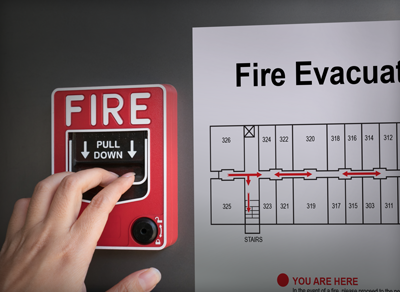Five Ways You Can Prevent Fires at Your Office
03
February,
2023
2 MINUTE READ

According to the National Fire Protection Association (NFPA), National Fire Prevention Week came into being almost a century ago as a grave reminder of the Great Chicago Fire of 1871. This famous fire "killed more than 250 people, left 100,000 homeless, destroyed more than 17,400 structures and burned more than 2,000 acres. The fire began on October 8, but continued into and did most of its damage on October 9, 1871," the NFPA states.
National Fire Prevention Week is observed annually on the Sunday through Saturday period in which October 9 falls, and it gives good cause for pause for many of us who work in the seemingly low fire risk environment of the office. The NFPA claims there are 3,340 office building fires annually, causing an average of four deaths and 44 injuries every year. Where there's people, there's fire risk; office blazes are less common on weekends because fewer people on location means fewer opportunities for ignition. The bulk of office fires occur between noon and 2 p.m. on weekdays.
 You can lessen your odds of having a fire burn out of control by 60% at your office by having a working smoke or fire alarm in your workplace. Here are four more ways you can prevent fire in your office:
You can lessen your odds of having a fire burn out of control by 60% at your office by having a working smoke or fire alarm in your workplace. Here are four more ways you can prevent fire in your office:
- The main cause of fire in the workplace is electricity and neglect or misuse of wiring, leading to short circuits that burn through rubbish and waste material. If there is accumulated waste such as loose papers and cardboard at your desk, fire spreads through these quickly. Make sure your area is free of paper clutter, and dispose paper products in central bins. Keep heat-producing equipment away from anything susceptible to burning, including copiers, coffee makers, and computers.
- Check your electrical cords. Are they fraying or damaged in any way? If they're attached cords, such as on a lamp, you may need to take them to the nearest appliance recycling center. If they're electrical cords or cables, dispose of them and use new cords or cables as needed. Better yet, place cords in places where they won't be stepped on, or where office chairs can't roll over them, as this will contribute to the deterioration of the protective outside coating.
- With cooking cited as the number one source of domestic fires, it makes sense that a heating apparatus such as a toaster can also be a fire hazard in an office. While personal fans and space heaters are OK (and need to be unplugged each night), many offices today don't allow toasters at your desk or office area.
OSHA standard 29 CFR 1910.303(b)(2) refers to personal appliance installation and use, and states that listed or labeled equipment shall be installed and used in accordance with any instructions included in the listing or labeling. Many OSHA inspectors cite this part of the standard by stating that the UL listing for the equipment in question, such as a toaster, is not approved for an industrial location. The solution? Keep toasters in a kitchen or breakroom area, if at all.
- Candles may smell and look pretty and can lighten the mood in the office. However, they can also literally light up paperwork, files, and the entire office if left unattended. According to the NFPA, "candles are inappropriate in most work locations and should not be permitted in any form. In some cities, they're prohibited by fire codes. In fact, for assembly occupancies to use even "protected" candles, permits are generally required. Candles in enclosed containers are available and considered safer than exposed ones."
An Ounce of Fire Prevention...
The most important way to ensure safety for employees in any facility or office, is to make sure they know where to go in the event of a fire. Preprinted fire and egress signage can easily point the way to exits. More information on enhancing safety through floor marking can be found in DuraLabel's Floor Marking Guide.
RELATED RESOURCES

Is Your Facility Fit for the Future?
Can your company keep up with the future demands of manufacturing, distribution, and e-commerce? Technology ...
Read
Fire won't wait. Plan your escape during National Fire Prevention Week October 9-15th
In 2021, local fire departments responded to 1,353,500 fires in the US. That averages out to one every 23 ...
Read
Five Questions with Alamodome Maintenance Manager Eric Duncan
The Alamodome is a five-tier stadium in the center of San Antonio, Texas. As well as holding pro soccer ...
Read.png)



